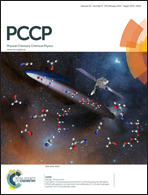Experimental and theoretical study on the sensing mechanism of a fluorescence probe for hypochloric acid: a Se⋯N nonbonding interaction modulated twisting process†
Abstract
In this article, the sensing mechanism of a fluorescence probe for hypochloric acid, NI–Se, has been investigated using experimental and theoretical methods. Based on the results of the steady-state and time-resolved emission spectra of NI–Se and its oxidized form NI–SeO, we suggested that there was twist internal charge transfer (TICT) state with faint fluorescence in NI–Se. Subsequently, the ground and excited state minimum geometries of NI–Se and NI–SeO were optimized with DFT/TD-DFT methods. The results demonstrated there was a twisting process in the excited state of NI–Se and that this twist process was induced by the nonbonding interaction between the Se and N atoms. In addition, the calculated spectra and molecular orbitals confirmed the charge transfer character of the TICT state in NI–Se. To further investigate the driving force behind the twist in NI–Se, we synthesized NI–O, which has no Se⋯N nonbonding interaction, as a control sample. Herein, we also present the characterization, fluorescence properties and the optimized geometries of NI–O. Moreover, the results showed that Se⋯N nonbonding interaction plays a significant role in the twisting process of NI–Se.


 Please wait while we load your content...
Please wait while we load your content...